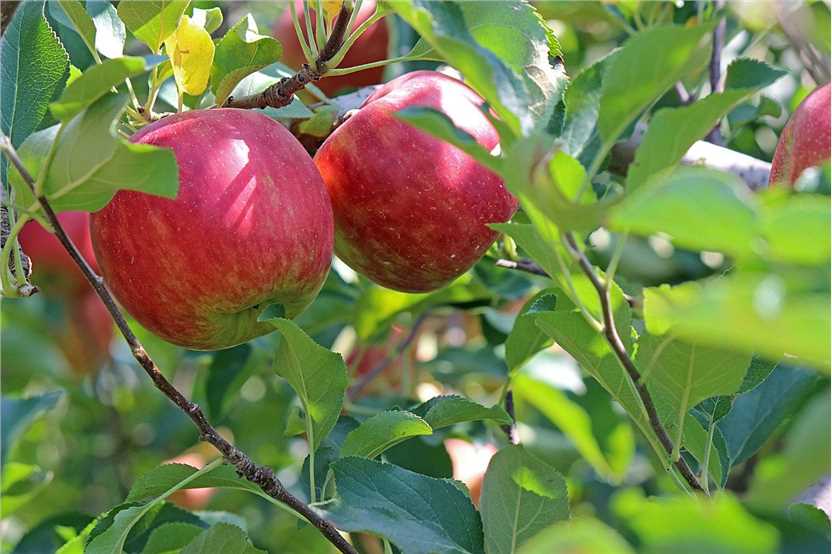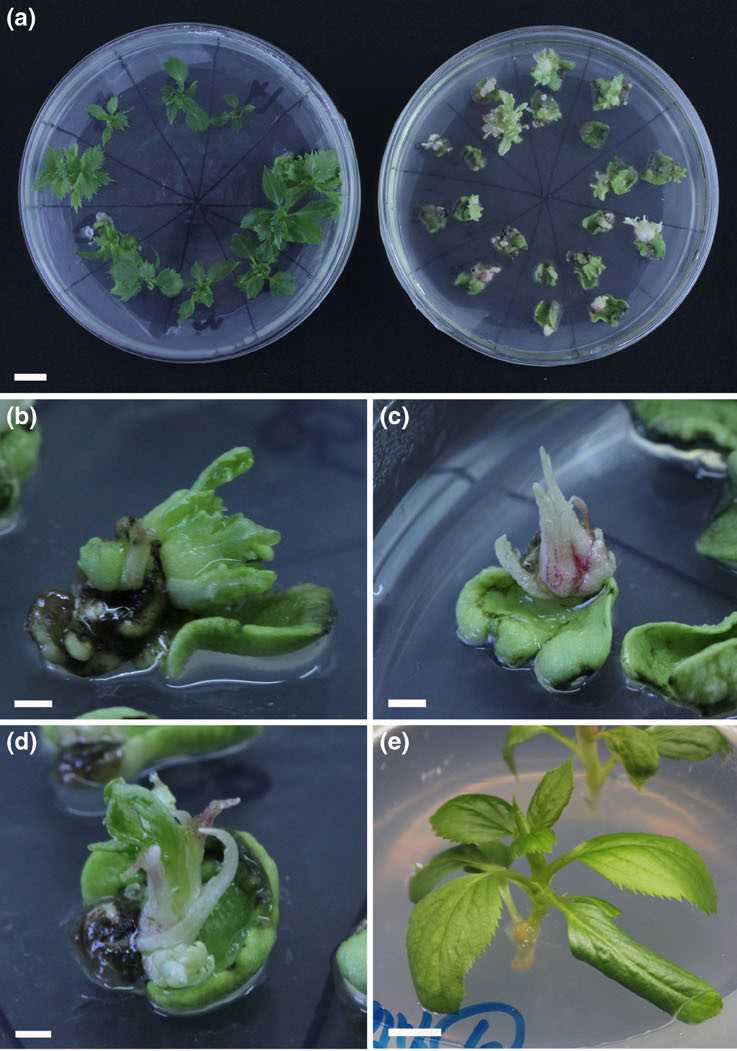Malus pumila Mill., also known as apple, is a plant of the genus Rosaceae, belonging to a deciduous tree. Apple has high nutritional value, rich in minerals and vitamins, and rich in calcium, which helps to metabolize excess salt in the body. Apple is a low-calorie food, producing only about 60 kilocalories per 100 g. At the same time, the malic acid contained in apple can metabolize excess calories and help prevent lower body obesity. The nutrients in apple are highly soluble and easily absorbed by human body, so it is called "living water". Apple is also good for dissolving sulfur and can make skin smooth and delicate. In order to further improve the characteristics of apple, increase the nutritional value of apple, reduce their cultivation costs, and shorten the cultivation cycle, many genetic modifications have been applied on apple.

Lifeasible provides one-stop services, covering all steps including experimental design, vector construction, plasmid transformation, positive transplant screening and characterization of transgenic Malus pumila Mill., our various genetic modification services are as follows:
Gene overexpression is an efficient tool for studying gene function. The development and utilization of gene overexpression technology has brought us many conveniences to study gene function and improving the yield of target products. Through the quantitative overexpression of genes related to fructose, malic acid, flavonoids, and other chemical components in Malus pumila Mill., the production of specific compounds can be increased. We could help our customer overexpress many genes including cold tolerance gene CIA2, high salt stress response gene MdMYB113, fructose synthesis gene SlLIN5, anti-brown spot disease gene MpCYS4, drought stress response gene MdEPF2, anti-ring disease related genes 4CL, COMT, EDS1, EDS2, adventitious root formation related oxygenase gene ARRO-1, and many other genes related to important traits of Malus pumila Mill.
RNAi technology is widely used in the field of gene editing, it is a phenomenon of specific gene silencing mediated by double-stranded RNA (dsRNA) at the transcription level and post-transcriptional level. Through RNAi technology, we can achieve silencing of multiple genes in Malus pumila Mill.
Virus induced gene silencing (VIGS) is a genetic technology that inhibits the expression of endogenous genes in plants by inserting recombinant viruses into target gene segments, they can induce plant endogenous gene silencing and cause phenotypic changes, and then study the function of target genes based on phenotypic changes. The VIGS technology is a method of transient transformation and thus can help our customers save time and obtain valuable information for gene functional analysis. With wealth of experience in VIGS, our scientists can provide you with customized protocol for VIGS in Malus pumila Mill.
CRISPR gene knockout technology is currently the most widely used gene knockout technology, it provides us with a very powerful and convenient gene editing tool. As a leading company that has been deeply involved in the field of gene editing for many years, using CRISPR technology, we can knockout Malus pumila Mill. genes in different ways, including frameshift mutations, multiple deletion of fragments, knockout of non-coding genes, knockout of multiple copies of genes, etc.
CRISPR system has strong scalability, and this scalability can be used to develop more useful gene editing tools. we have developed many methods that can improve gene knock-in efficiency and achieve precise editing of the Malus pumila Mill. genome. For the gene knock-in process, most of them is done through HDR. However, NHEJ and HDR will occur at the same time due to DNA breaks. Therefore, we have developed different methods to increase the probability of HDR, thereby improving the efficiency of gene knock-in process.
CRISPR single base editing technology is a hot area of life science research today. As a company that has been cultivating gene editing technology for decades, Lifeasible could help you achieve the conversion from C to T or A to G in Malus pumila Mill. using CBE and ABE, both of which rely on the DNA positioning capabilities of the CRISPR/Cas9 system. During single base editing, the C base deaminase or A base deaminase is located at a specific position in the genome, and it catalyzes the deamination reaction of C or A at a specific position and turns it into U or I. Then it is treated as T or G in the process of DNA replication, realizing the conversion from C to T or A to G.
Sequence-specific control of gene expression on a genome-wide scale is an important approach for understanding gene functions and for engineering genetic regulatory systems,. There are many ways to participate in the inhibition of gene expression, one of them is CRISPR Interference (CRISPRi). For the inhibition of Malus pumila Mill. genes, we can provide a variety of solutions, including dCas9 binding to targeted DNA and realizing Inhibition of gene transcription through steric hindrance. In addition, gene knockdown can also be achieved by recruiting a fusion protein to the start site of gene transcription.
CRISPRa technology uses the powerful capabilities of Cas9 and sgRNA to fuse or recruit multiple proteins to enhance gene transcription. For Malus pumila Mill. genes, we provide VPR technology, SAM technology and Suntag technology to allow the CRISPR system to carry more activation element and achieve a stronger activation effect after synergistic amplification.
The study of gene function has always been the core subject of biological research. The earliest genetic screening system established through forward genetics is very inefficient and has a huge workload. However, the reverse genetic screening system based on CRISPR technology can complete very low-cost mutation library construction work. The gene mutation library construction technology we provide for Malus pumila Mill. including gene knockout library construction, gene knockdown library construction, and gene activation library construction. Moreover, single-cell sequencing is available for mutation screening.
DNA-free gene editing technology has received extensive attention from the industry in recent years. We provide DNA free Malus pumila Mill. genome editing services, including transient expression of CRISPR/Cas9 plasmid DNA, in vitro transcription of CRISPR/Cas9, and pre-assembled ribonucleic acid composed of purified Cas9 protein and sgRNAs complex. These technologies can avoid the integration of foreign DNA and genome, and reduce off-target effects. In addition, compared with traditional techniques, these techniques can avoid the use of hybridization or backcrossing to isolate CRISPR/Cas9 chimeras, so they are cheaper and have shorter experimental cycles.
Genetic Transformation Process for Malus pumila Mill.
The most advanced and widely used method for the development of genetically modified Malus pumila Mill. is Agrobacterium-mediated transformation of cotyledons (Figure 1).
 Figure 1. Agrobacterium mediated Malus pumila Mill. Transformation. (a) Shoots developed from embryo buds (left) and buds regenerated from cotyledons of M. micromalus transformed by Agrobacterium (right) after 30 d of culture. (b) Green bud after 4 weeks of selection on medium containing kanamycin. (c) White bud after 4 weeks of selection on medium containing kanamycin. (d) Chimeric bud after 4 weeks of selection on medium containing kanamycin. (e) Resistant shoot developed from green bud. (Dai H, et al. 2014)
Figure 1. Agrobacterium mediated Malus pumila Mill. Transformation. (a) Shoots developed from embryo buds (left) and buds regenerated from cotyledons of M. micromalus transformed by Agrobacterium (right) after 30 d of culture. (b) Green bud after 4 weeks of selection on medium containing kanamycin. (c) White bud after 4 weeks of selection on medium containing kanamycin. (d) Chimeric bud after 4 weeks of selection on medium containing kanamycin. (e) Resistant shoot developed from green bud. (Dai H, et al. 2014)
Adapting to diverse purposes of different customers, multiple Agrobacterium strains (EHA105, LBA4404, C58, GV2260, GV3101), as well as commercial and customized binary vectors with variant selectable markers (Kanamycin, Hygromycin, Phosphinothricin, G418, etc.) are available. Experts at Lifeasible obtain comprehensive knowledge and years of experience to solve technical problems and challenges in Malus pumila Mill. transformation. We can draw customized solution to help you research on a variety of Malus pumila Mill. genes and varieties. For more information or any inquiry requirements, please contact Lifeasible.
Reference